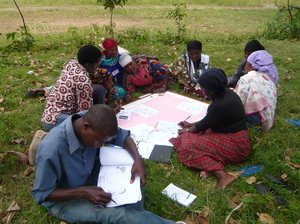Little attention paid to how health interventions are designed
27 April 2016

Funders and researchers need to recognise the social, political and economic factors that affect the development of interventions to improve health care, a new study suggests.
There is increasing demand for evidence of "what works" to improve health care, and much discussion about how to produce such evidence. This process usually focuses on methods to evaluate interventions, but the methods to design them are just as important and have been neglected.
The conclusions were published in the paper “Examining intervention design: lessons from the development of eight related malaria health care intervention studies”, published in Health Systems & Reform, which compiles lessons learned from ACT Consortium projects in five malaria endemic countries.
Teams of clinicians, public health practitioners, economists, anthropologists, epidemiologists and statisticians developed eight interventions to improve malaria case management.
Changing social settings rather than individual behaviour
Dr Clare Chandler, from the London School of Hygiene & Tropical Medicine and Lead Social Scientist of the ACT Consortium, explained that “with the goal to improve malaria case management, but working in different health systems and countries, the ACT Consortium could not rely on simple standardised interventions.”
She added: “In particular, the overdiagnosis of malaria has been a deeply embedded social practice which does not necessarily fit well with recommendations from the WHO to test patients’ blood before treating them. Interventions therefore needed to go beyond the behaviour of individuals, acknowledging that health care is produced through dynamic social, political and economic processes.”
In most studies, researchers supplied antimalarials and rapid diagnostic tests as well as training to support a change through communities of practice. Interventions included group learning, self-reflection tasks, dramas, peer education, supervisory visits, tools for referral of patients, requisition of supplies, and distribution of posters and leaflets.
From scoping to testing: four key steps to design an intervention
First, researchers identified the target problem and the audience, involving ministries of health and clinicians in the process. The intervention should be as flexible as possible, allowing it to be adapted to fit local contexts, such as different health facilities and schools. Ultimately, researchers wanted to produce interventions that could be scaled up in low resource settings.
Second, the teams reviewed evidence from medicine, incorporated theories from health psychology and, most of all, conducted formative research to understand the scale of the problem in the context of the intervention.
The third step was to carefully design evidence-based interventions, using workshops to review research and inviting stakeholders to ensure the materials fitted with what they found relevant and feasible to sustain.
Finally, researchers invited the end users – such as health workers and patients – to refine the content, message, mode of delivery and visuals of the materials. Each draft material was tested several times until the quality, suitability and comprehension of the final product was sufficient to allow for its implementation and evaluation.
A costly, yet crucial process
The paper states that the resources needed to design interventions exceeded expectations, taking between six months and two years, and costing around 10% of the overall budget. The highest costs were household surveys used in formative research and the professional development of intervention materials.
“Intervention design is a crucial, yet often neglected process in the field of health care research. It’s time more attention is paid to how it is done,” Dr Chandler suggested. “In the same way as trial protocols are now requested to be published, we argue strongly that the process of intervention development should also be routinely reported.”
Photo: Artist drafts and amends pictures of study patient leaflet in real time in line with suggestions from community members (Credit: Clare Chandler)
Further information
- Download the Starter Kit to to develop malaria diagnosis and treatment interventions in endemic countries

